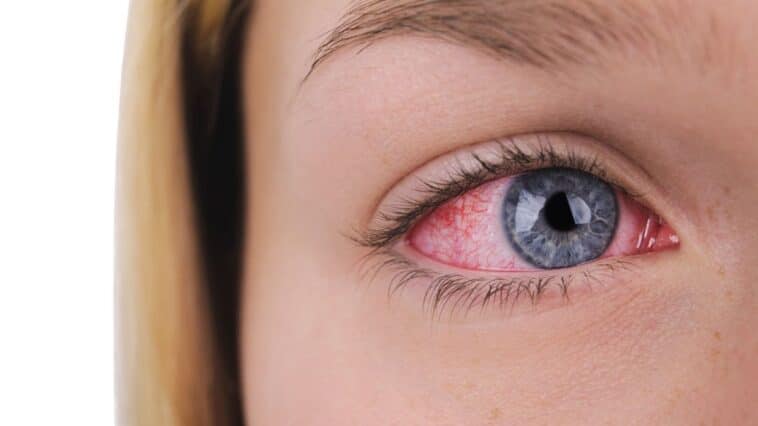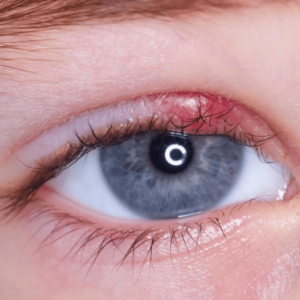Red eyes is a term commonly used to describe the redness or bloodshot appearance of the whites of the eyes. It is usually caused by dilated blood vessels in the eye, which can result from various factors such as fatigue, dry eyes, eye strain, allergies, or eye infections.
In some cases, red eye can be a symptom of a more severe condition, such as conjunctivitis, iritis, or uveitis. If the redness is accompanied by other symptoms, such as pain, vision changes, or discharge, it is vital to seek medical attention.
What Causes Red Eyes?
Various factors can cause red eyes, including:
- Eye strain or fatigue: Prolonged use of computers or other digital devices can lead to eye fatigue and cause redness.
- Dry eyes: Not enough tears can cause the eyes to become dry, irritated, and red.
- Allergies: Allergic reactions can cause red, itchy, and watery eyes.
- Conjunctivitis (pink eye): This is an infection of the clear membrane that covers the eyes’ whites and the eyelids’ inside.
- Irritants: Exposure to smoke, wind or other irritants can cause the eyes to become red and irritated.
- Eye infections: Bacterial or viral infections can cause the eyes to become red, swollen, and painful.
- Chronic conditions: Some medical conditions, such as glaucoma or uveitis, can cause eye redness.
In some cases, red eye can signify a more serious condition and requires medical attention. If you are experiencing persistent or severe redness, it is crucial to seek medical advice.
Symptoms of Red Eyes
The symptoms of red eyes can include:
- Redness or bloodshot appearance of the whites of the eyes
- Swelling or puffiness of the eyelids
- Itching or burning sensation
- Discharge or tearing
- Pain or discomfort
- Light sensitivity
- Blurred or decreased vision
- A feeling of a foreign object in the eye
Red eyes can accompany other symptoms such as a headache, runny nose, or skin rash. If you are experiencing persistent or severe symptoms, it is crucial to seek medical attention.
Diagnose the Cause of Your Red Eyes
The cause of red eyes can be determined through a medical examination. The following steps are typically involved in diagnosing the cause of red eyes:
- Medical history: Your doctor may ask you about your medical history, including any underlying medical conditions and symptoms you are experiencing.
- Physical examination: Your doctor will examine your eyes, including the eyelids, cornea, and retina, to assess the extent of the redness and any other signs of eye damage or disease.
- Tests: Your doctor may perform tests, such as a visual acuity test or a fluorescein eye stain test, to determine the cause of your red eyes.
- Treatment: Based on the results of the examination and tests, your doctor will determine the best course of treatment for your red eyes. This may include medications, such as eye drops or oral medications, or other treatments, such as a change in lifestyle or eyeglasses.
It is essential to seek medical attention if you are experiencing persistent or severe redness in your eyes, especially if you have other symptoms, such as pain, vision changes, or discharge. An accurate diagnosis and prompt treatment are essential in preventing further eye damage or vision loss.
Treatment for Red Eyes
Several things can cause red eyes, and the best treatment may vary depending on the root cause. Possible treatments include:
- Eye drops: Artificial tears or anti-inflammatory eye drops can help relieve dry eyes or irritation.
- Antihistamines: If allergies cause red eyes, your doctor may prescribe antihistamines.
- Antibiotics: If a bacterial infection causes red eyes, your doctor may prescribe antibiotics.
- Surgery: If a blockage of the tear duct causes your red eye, surgery may be required as a treatment option. During the procedure, the doctor will work to remove the blockage so that regular tears can flow and maintain healthy moisture in your eyes.
If you have red eyes that do not improve or experience any new, unusual, or worsening symptoms, it is crucial to see a doctor for proper diagnosis and treatment. Follow your doctor’s instructions to ensure your eyes stay healthy.
Home Remedies To Relieve Red Eyes
Red eyes may indicate a severe medical condition and should be treated accordingly. However, certain home remedies can provide relief. They include:
- Warm compresses: Placing a warm compress over your closed eyes can help relieve swelling and redness.
- Artificial tears: Using artificial tears or saline solution can help relieve dry eyes and irritation.
- Cold compresses: Placing a cold compress over your closed eyes can help reduce swelling and redness caused by eye strain or fatigue.
- Hydration: Drinking plenty of water can help prevent dry eyes and maintain eye health.
- Rest: Getting enough sleep and reducing stress can help prevent red eyes caused by eye strain or fatigue.
- Lifestyle changes: Avoiding irritants and wearing protective eyewear can help prevent red eyes caused by exposure to wind, smoke, or other irritants.
- Aloe vera: Applying aloe vera gel or juice to the affected eye can help soothe irritated eyes and reduce redness.
It is important to note that these home remedies are not intended to replace medical treatment. If you are experiencing persistent or severe redness or other symptoms, it is crucial to seek medical attention.
What Are The Complications of Eye Redness?
Red eyes can be a sign of an underlying condition that, if left untreated, can lead to complications. Some possible complications of eye redness include:
- Vision loss: If left untreated, some conditions that cause red eyes, such as glaucoma or macular degeneration, can lead to vision loss.
- Scarring: Eye infections or other conditions that cause red eyes can lead to cornea scarring, which can affect vision.
- Perforation: In some cases, eye infections or other conditions can cause a hole in the cornea, leading to vision loss and other complications.
- Blindness: In rare cases, severe eye infections or other conditions that cause red eyes can lead to blindness.
- Secondary infections: If red eyes are not treated properly, they can become infected with other bacteria or viruses, leading to further eye damage and vision loss.
It is essential to seek prompt medical attention if you are experiencing persistent or severe redness in your eyes, especially if you have other symptoms, such as pain, vision changes, or discharge. An accurate diagnosis and prompt treatment are essential in preventing further eye damage or vision loss.
How Can You Prevent Eye Redness?
Here are some tips for preventing eye redness:
- Maintain good eye hygiene: Wash your hands frequently and avoid touching your eyes with unclean hands. This can help prevent the spread of bacteria and other germs that can cause eye infections and other conditions.
- Use artificial tears: If you have dry eyes, use artificial tears or other eye moisturizers to help keep your eyes hydrated and prevent redness.
- Get enough sleep: Getting enough sleep and reducing stress can help prevent eye strain and fatigue, which can cause red eyes.
- Wear protective eyewear: When participating in activities that can cause eye irritation or injury, such as playing sports or working with hazardous materials, wear protective eyewear to help prevent red eyes.
- Avoid irritants: Avoid exposure to irritants, such as smoke, wind, or strong chemicals, that can cause red eyes.
- Manage underlying medical conditions: If you have an underlying medical condition, such as allergies or chronic eye disease, it is crucial to managing this condition to help prevent red eyes.
- Regular eye exams: Regular eye exams can help detect early signs of eye conditions and allow for prompt treatment to prevent further eye damage or vision loss.
Following these tips can help prevent red eyes and maintain good eye health.
When Should You See an Eye Doctor?
You should contact a doctor if you experience the following symptoms in conjunction with red eyes:
- Pain or discomfort: If your red eyes are painful or feel irritated, it may be a sign of an underlying eye infection or other condition that requires medical attention.
- Vision changes: If you experience vision changes, such as blurry vision or double vision, in conjunction with red eyes, it may be a sign of a severe eye condition that requires prompt medical attention.
- Discharge or tearing: If your red eyes are accompanied by discharge or excessive tearing, it may be a sign of an eye infection or other condition that requires medical attention.
- Light sensitivity: If you are experiencing light sensitivity in conjunction with red eyes, it may be a sign of an underlying eye condition that requires medical attention.
- Persistent symptoms: If your red eyes persist for several days or worsen over time, it is essential to seek medical attention.
In general, it is a good idea to see your eye doctor if you experience any new or worsening symptoms in your eyes. A prompt diagnosis and treatment can help prevent further eye damage or vision loss.
Summary
Various factors, including eye strain, fatigue, exposure to irritants, and underlying medical conditions, can cause red eyes. If left untreated, red eyes can lead to complications, such as vision loss, scarring, perforation, blindness, and secondary infections.
Maintaining good eye hygiene, getting enough sleep, wearing protective eyewear, avoiding irritants, managing underlying medical conditions, and having regular eye exams to prevent red eyes are essential.
If you experience persistent or severe red eyes accompanied by other symptoms, it is crucial to seek medical attention to prevent further eye damage or vision loss.






